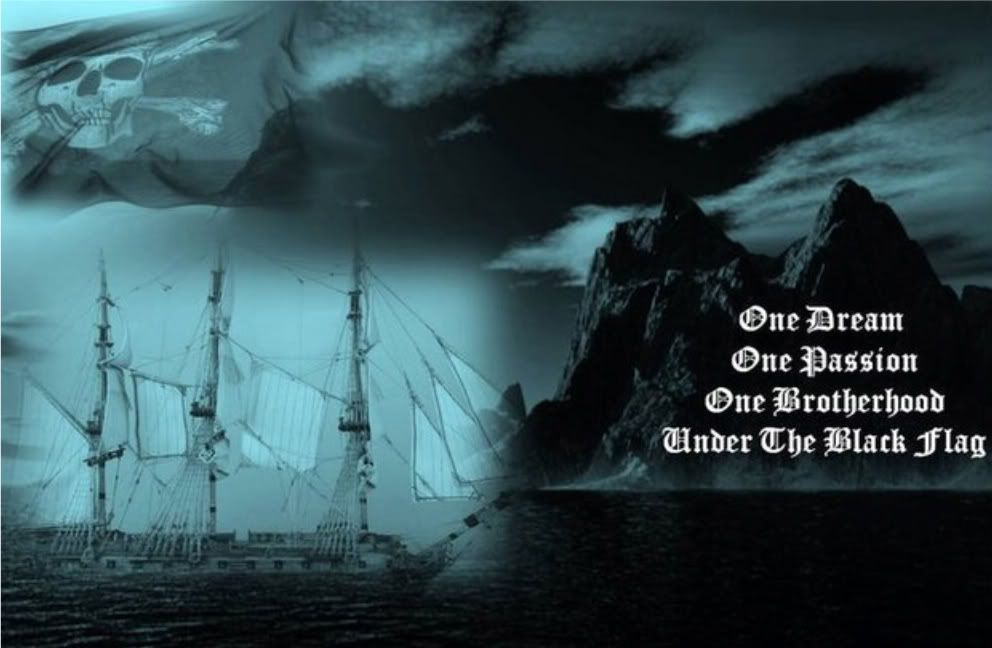The Black Flag
articles, Under The BLack Flag 5:28 π.μ.
"Why is our flag black? Black is a shade of negation. The black flag is the negation of all flags. It is a negation of nationhood which puts the human race against itself and denies the unity of all humankind. Black is a mood of anger and outrage at all the hideous crimes against humanity perpetrated in the name of allegiance to one state or another."
We all know that pirates flew the 'Jolly Roger' - the skull and cross-bones flag. The most likely derivation of the name 'Jolly Roger' is as an Anglicisation of the French Jolie Rouge - the red or 'bloody' flag that pirates originally used before the more well-known black. The red flag is widely known as the international symbol of proletarian revolution and revolt and the black flag has historically been the flag of the anarchist movement. (These two colours were most famously combined in the anarcho-communist red and black flags of the Spanish revolution of 1936.
The earliest definite report of the black flag being flown by anarchists or used in working class revolt is of the famous anarchist Louise Michel leading a crowd of rioting unemployed to ransack bakers' shops with a black flag on March 9th 1883. However there are reports that she had flown a skull and cross-bones flag 12 years earlier in 1871, while leading the women's battalions of the insurrectionary Paris Commune. The Paris Commune even had a daily paper called Le Pirate.
In June 1780 when the prisons of London were broken open and the prisoners freed during the Gordon Riots we find this description: "A giant of a man had been seen riding a cart-horse and waving an immense black and red flag, like the standard bearer of an opposing army." This man's name was James Jackson and he led the masses to destroy London's main prison with a shout of "A-hoy for Newgate!" It would not be reading too much into it to suggest that this "a-hoy!" might indicate Jackson was a sailor - sailors had always been the most militant section of the working class, in which case this black and red flag signalling a call to freedom on the streets of London could easily have direct links to the black and red flags of the Caribbean several years earlier. This thus considerably pre-dates Louise Michel and almost puts us back in the hey-day of the pirates.
The red and black flew again in the Caribbean in 1791. After a huge slave revolt, part of the old pirate stronghold of Hispaniola took instead the Native American name "Haiti" and became the world's first independent black republic. Led by Toussaint L'Ouverture, the rebels defeated the forces of three empires to win their liberty. The red and black flag of Haiti became a banner of freedom to eighteenth and nineteenth century blacks, especially to sailors who would sail to Haiti, become Haitians and then return home flying a red and black flag. American slaves aboard naval and merchant vessels would flee and seek refuge in Haiti.
Of a certain William Davidson, we are informed: "at a demonstration he protected the black flag with skull and cross bones, 'Let us die like Men and not be sold like Slaves,' the flag said." Davidson was a black man born in 1786 and executed in 1820. He was born in Kingston, Jamaica - erstwhile 'wickedest city on the earth' and notorious pirate capital. He spent three years at sea, was a trade unionist, read Tom Paine and may have had some connection to Toussaint L'Ouverture and the revolution in Haiti. He was finally executed on Mayday 1820 with others for being part of the 'Cato Street conspiracy' to assassinate the entire cabinet while they were at dinner. This was intended to lead to attacks on Mansion House and the Bank of England, the seizing of artillery and to give the spark for a revolution in Britain!
Be Proud to fly the Jolly Roger!












